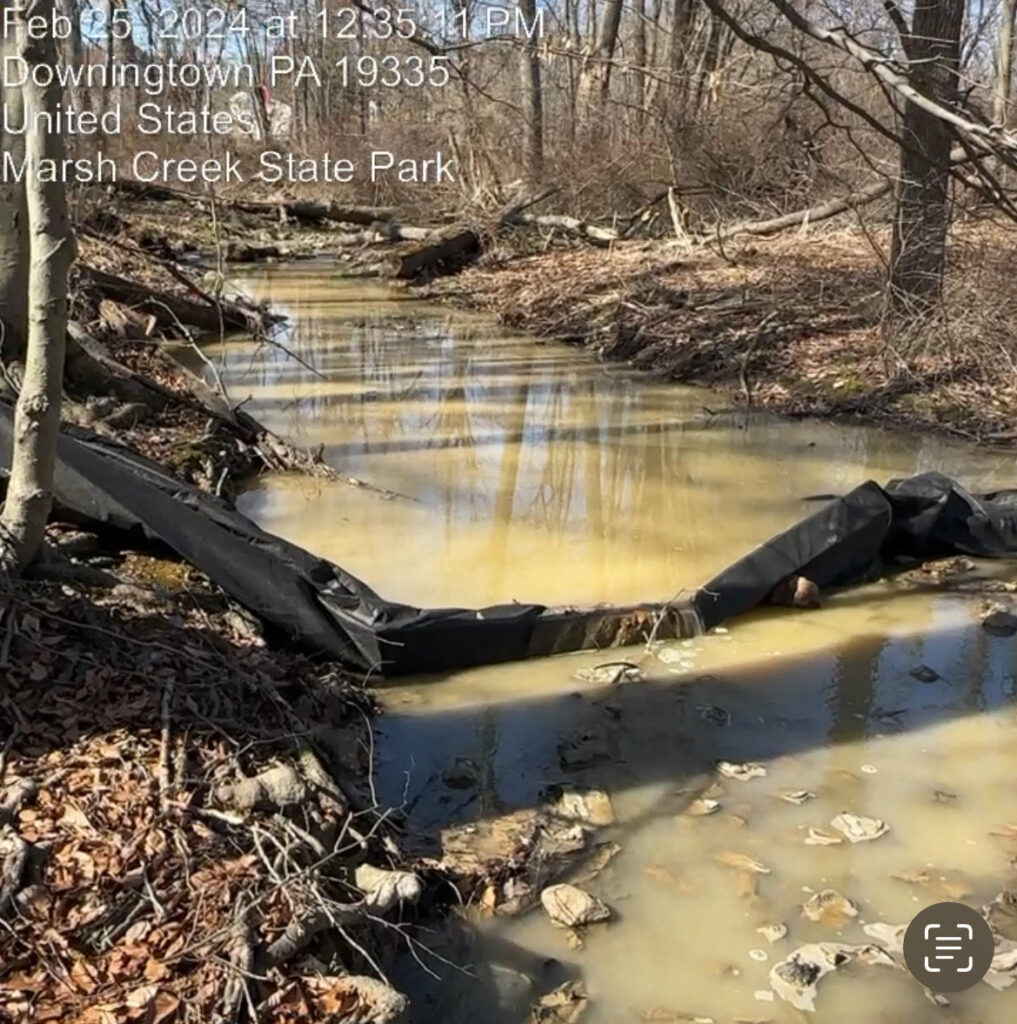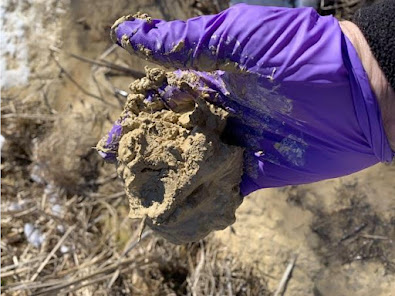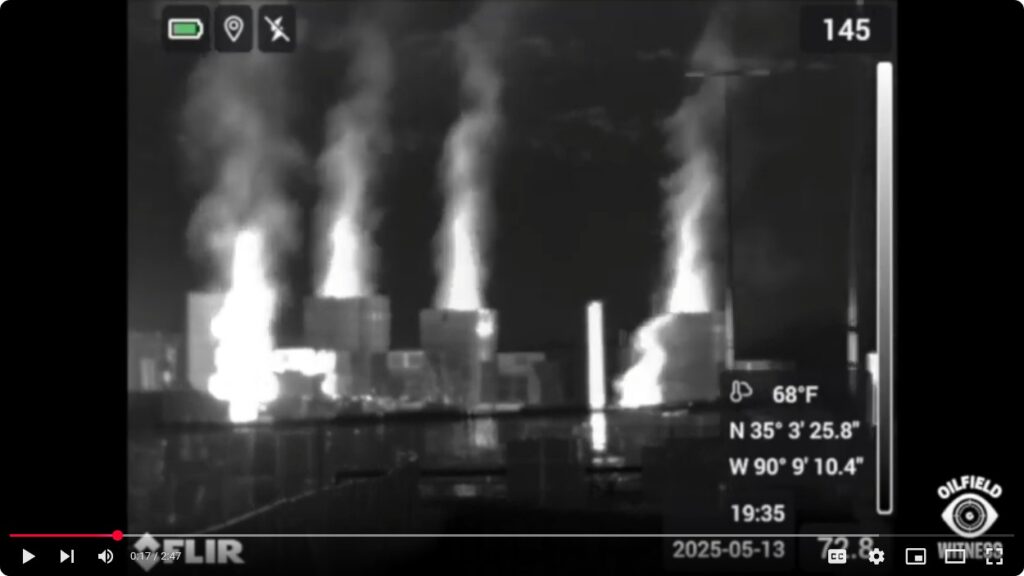On February 15, Pennsylvania’s environmental regulator received an anonymous complaint that a mysterious white material was covering the bottom of a creek in Chester County — a tributary of nearby Marsh Creek Lake located about a thousand feet from the underground Mariner East pipeline.
A day later, an inspector from the state’s Department of Environmental Conservation confirmed that the clay-like material was flowing from a nearby sinkhole into the stream and nearby wetlands.
On February 22, the DEP tested its own sample and also turned samples of the material over to Sunoco Pipeline, L.P. (SPLP) for testing. SPLP is a subsidiary of Energy Transfer Partners, which built, owns, and operates Mariner East, a $5 billion, 350-mile pipeline that carries natural gas and liquids (NGL) across Pennsylvania.
Seven days later, a DEP representative told a meeting of Chester County environmental officials that the testing by DEP and SPLP had identified the white ooze as a “naturally occurring” material, but didn’t state what exactly the substance was.
Now local activists want to do an independent investigation, because they fear the spill may contain bentonite, a material commonly used in drilling fluid that has surfaced in the area before, and is potentially harmful to the environment.
Having SPLP to do their own testing was “like handing the evidence over to the criminal,” said Chris “P.K.” Digiulio, a local resident and activist who lives on Marsh Creek Lake and has dedicated years to fighting the Mariner East pipeline.
Digiulio took samples from the site a few days after the DEP inspected the area, and now Physicians for Social Responsibility (PSR) Pennsylvania, the non-profit group where Digiulio works as an environmental chemist, is raising funds to independently test the clay-like material. The group needs about $8,000 for the test.
The DEP was so quick to give samples to Sunoco for testing, instead of sending them to an independent lab, that it made residents wary, Digiulio said. “We have a regulatory agency that’s supposed to protect us, but it feels like I’m doing their job.”
A Lack of Transparency
Digiulio and other locals don’t trust that Sunoco is being transparent about this incident, which is just the most recent in the pipeline’s troubled history. Energy Transfer Partners faced a series of steep environmental penalties during construction of Mariner East, which was plagued with problems throughout construction, including major drilling mud spills.
Parts of Mariner East’s construction involved horizontal directional drilling, an underground construction method that often causes sinkholes according to the Natural Resources Defense Council.
Energy Transfer paid more than $4 million in penalties for a 2020 sinkhole that released almost 28,000 gallons of drilling fluid into Marsh Creek Lake, which is located within a state park. The company has so far amassed $42 million overall in pollution fines related to the project.
Digiulio, a one-time Green Party candidate for governor, told DeSmog that any community living near Mariner East could end up in the same sort of struggle with state officials.
“There are 350 miles of this pipeline, and this is not the only place spills have happened,” she said. “The only reason this has gotten attention is because of the work of the watchdogs.”
Digiulio said that following the release of the DEP’s report in mid-February, cleanup crews with squeegees and buckets showed up to clear the area. Workers covered the collected material with hay and sequestered it in a containment area to dry it out, she said.
This activity raised a red flag for State Sen. Katie Muth, who represents Chester County. “If the material is nontoxic, why does it have to be put in a containment area?” she said. “If it’s naturally occurring, there should be no need to remove it.”
In response to DeSmog’s request for comment, Energy Transfer spokesperson Lisa Coleman said that “the major component of the material found is kaolinite, which is not a component of drilling mud or grout used in pipeline construction activities.”
Stephanie Berardi, spokesperson with the DEP, told DeSmog that Sunoco obtained a permit that includes a corrective action plan requiring the company to remove the material from the site by hand, and provide post-removal restoration and monitoring. However, she said, “it is not possible to assess whether the site has been ‘completely’ cleaned up.”
However, Muth and Digiulio are still concerned that the spill could contain bentonite clay, a key component of the drilling process that forms a gel when mixed with water to create a stable base for drilling fluid.
The drilling fluids used during Mariner East’s construction contained bentonite, according to Muth.
While small amounts of bentonite generally have negligible impacts on the environment, larger quantities can be harmful, Neil Shader, another DEP spokesperson, told DeSmog. “Drilling mud released into streams can coat streambeds and smother aquatic life and plants,” he said, while “releases into groundwater aquifers can cause turbid and discolored water and decrease the overall effectiveness of a drinking water well.”
Leaks of drilling fluid are a regular occurrence in pipeline communities, said Digiulio, as heavy rains and melting snow soak into the ground and force the fluid to the surface.

“The average person might not realize how frequently we are exposed to things that we aren’t even told about that can literally ruin your health,” Muth said.
Sunoco’s Coleman dismissed these concerns. “It is unfortunate that so many rushed to judgment without knowing the facts, including elected officials,” said Coleman. “We hope that the elected officials who issued public statements based on unsubstantiated information will issue a follow-up statement correcting information, and instead use their platform to inform their constituents of accurate information rather than unverified rumors.”
Still, it’s understandable that the community would become alarmed at any type of substance found along Mariner East’s route, said Muth, because of its history of environmental accidents. If PSR’s independent testing confirms Sunoco’s results, she hopes it will ease the community’s worries surrounding the February spill.
“The implications are, is the agency being honest in their efforts to uphold peoples’ right to clean air and clean water?” said Muth. “We know we’re dealing with a repeat polluter, but is the government holding polluters accountable?”
Subscribe to our newsletter
Stay up to date with DeSmog news and alerts







